Sheet pan
A sheet pan, baking tray or baking sheet is a flat, rectangular metal pan used in an oven. It is often used for baking bread rolls, pastries and flat products such as cookies, sheet cakes, Swiss rolls and pizzas.
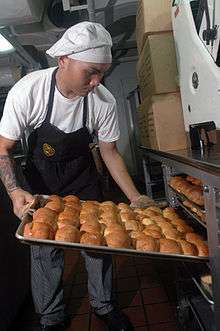
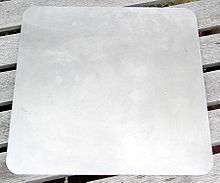
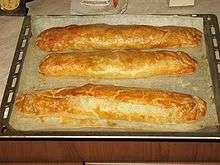

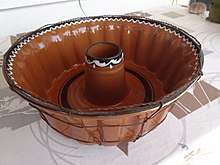
These pans, like all bakeware, can be made of a variety of materials, but are primarily aluminum or stainless steel. The most basic sheet pan is literally a sheet of metal. Commercial pans are sometimes made from aluminized steel which combines the conductive, reflective, and food adherence properties of aluminum, with the rigidity, mass, and strength of the inner steel core (in this process, the aluminum surface is typically 90% aluminum and 10% silicon, which is not quite the same as pure aluminum).
Common features that may be found in sheet pans include: one or more flat edges to assist food removal, one or more raised edges (lips) to retain food, a contiguous rim to retain either food or shallow liquid, handles to assist in moving the pan into and out of the oven, a layer of insulation (typically air) designed to protect delicate food from burning (air bake pan), or perforations to aid in speeding cooking (pizza tray).
Rigidity of the pan is especially important if the pan is to be placed directly on a flat heat source (hearth stone, induction element, etc.) Rims and ridges contribute to rigidity.
Mass, thermal conductivity, and colour of the pan play key roles in achieving a uniform cooking temperature. The friction of the pan's under surface may be a safety consideration in some applications.
Unlike other bakeware, smaller sheet pans function as convenient task trays.
Types and sizes
A sheet pan that has a continuous lip around all four sides may be called a jelly roll pan. A pan that has at least one side flat, so that it is easy to slide the baked product off the end, may be called a cookie sheet.
Professional sheet pans used in commercial kitchens typically are made of aluminum, with a 25 mm (1 in) raised lip around the edge, and come in both standard and non-standard sizes. Within each standard, other commercial kitchen equipment, such as cooling racks, ovens, and shelving, is made to fit these standard pans. In many cases, American and European sizes are matched closely enough to be used interchangeably.
Typically, for rimmed trays, each rim will sacrifice 10–20 mm (0.5–0.75 in) of baking surface along that edge. Pans of a single design from a single vendor will usually share the same rim height and rake across all tray sizes in a series, thus the sacrifice of flat baking surface is proportionally greater (relative to outer dimension) for small pans than for large pans.
While nominally half the size—and typically sharing one dimension—quarter sheets will not necessarily nest inside a half sheet side by side (whether for storage or other purposes). Some vendors supply quarter sheets that are half the size of a half sheet in outer dimension, while other vendors supply quarter sheets that are closer to half the size of a half sheet in flat baking area.
European sizes
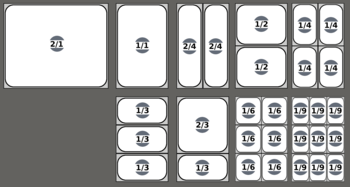
European standard pan dimensions are governed by GN numbers under European Committee for Standardization EN 631.
| Gastronorm sizes | Dimensions |
|---|---|
| GN2/1 | 650 × 530 mm |
| GN1/1 | 530 × 325 mm |
| GN2/3 | 354 × 325 mm |
| GN2/4 | 530 × 162 mm |
| GN1/2 | 325 × 265 mm |
| GN1/3 | 325 × 176 mm |
| GN1/4 | 265 × 162 mm |
| GN1/6 | 176 × 162 mm |
| GN1/9 | 108 × 176 mm |
European sized trays usually come in standard depths of 20, 40, 65, 100, 150 and 200 mm.
U.S. sizes
In American sizing, the full-size sheet pan is 26 in × 18 in (660 mm × 460 mm), which is too large for most home ovens. A two thirds sheet pan (also referred to as a three quarter size sheet pan) is 21 in × 15 in (530 mm × 380 mm). A half sheet pan is 18 in × 13 in (460 mm × 330 mm); quarter sheets are 9 in × 13 in (230 mm × 330 mm). The half sheet is approximately the same size as mass-market baking sheets found in supermarkets, and the quarter sheet is a common size for rectangular, single-layer cakes.
| Conventional U.S. Size Name | Outer width (in) |
Outer depth (in) |
Outer height (in) |
Outer width (mm) |
Outer depth (mm) |
Outer height (mm) |
|---|---|---|---|---|---|---|
| Full | 26 | 18 | 1 | 660 | 457 | 25 |
| 21 | 15 | 1 | 533 | 381 | 25 | |
| Half | 18 | 13 | 1 | 457 | 330 | 25 |
| Quarter | 13 | 9.5 | 1 | 330 | 241 | 25 |
| Eighth | 9.5 | 6.5 | 1 | 241 | 165 | 25 |
Note that values are approximate and vary based on rim size and style.
Institutional use
Commercial sheet pans are used for many purposes besides baking. Kitchen or cooking processes are often designed around kitchen equipment such as sheet pans, presupposing their ubiquity in most commercial food preparation areas.
In bread baking, especially, the bread dough will often go through several long rest intervals on sheet pans stacked in open or enclosed sheet pan racks (sometimes mounted on wheels). Enclosed racks may also be ventilated or temperature controlled to some degree.
See also
- Gastronorm sizes, European standardized cookware dimensions
- Parchment paper, sometimes used for lining sheet pans
- Tray
References
External links

